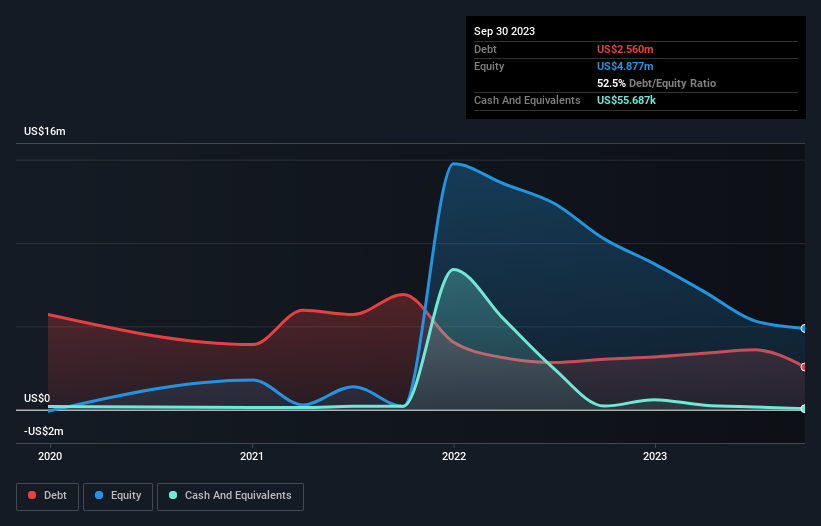
Some say volatility, rather than debt, is the best way to think about risk as an investor, but Warren Buffett famously said that 'Volatility is far from synonymous with risk.' It's only natural to consider a company's balance sheet when you examine how risky it is, since debt is often involved when a business collapses. Importantly, Kidpik Corp. (NASDAQ:PIK) does carry debt. But the real question is whether this debt is making the company risky.
Why Does Debt Bring Risk?
Debt assists a business until the business has trouble paying it off, either with new capital or with free cash flow. In the worst case scenario, a company can go bankrupt if it cannot pay its creditors. However, a more common (but still painful) scenario is that it has to raise new equity capital at a low price, thus permanently diluting shareholders. Of course, plenty of companies use debt to fund growth, without any negative consequences. When we examine debt levels, we first consider both cash and debt levels, together.
See our latest analysis for Kidpik
How Much Debt Does Kidpik Carry?
You can click the graphic below for the historical numbers, but it shows that Kidpik had US$2.56m of debt in September 2023, down from US$3.03m, one year before. However, because it has a cash reserve of US$55.7k, its net debt is less, at about US$2.50m.

How Healthy Is Kidpik's Balance Sheet?
Zooming in on the latest balance sheet data, we can see that Kidpik had liabilities of US$5.13m due within 12 months and liabilities of US$853.3k due beyond that. On the other hand, it had cash of US$55.7k and US$147.5k worth of receivables due within a year. So its liabilities total US$5.78m more than the combination of its cash and short-term receivables.
The deficiency here weighs heavily on the US$3.37m company itself, as if a child were struggling under the weight of an enormous back-pack full of books, his sports gear, and a trumpet. So we'd watch its balance sheet closely, without a doubt. After all, Kidpik would likely require a major re-capitalisation if it had to pay its creditors today. There's no doubt that we learn most about debt from the balance sheet. But it is Kidpik's earnings that will influence how the balance sheet holds up in the future. So if you're keen to discover more about its earnings, it might be worth checking out this graph of its long term earnings trend.
In the last year Kidpik had a loss before interest and tax, and actually shrunk its revenue by 8.3%, to US$16m. We would much prefer see growth.
Caveat Emptor
Importantly, Kidpik had an earnings before interest and tax (EBIT) loss over the last year. Indeed, it lost a very considerable US$7.6m at the EBIT level. Considering that alongside the liabilities mentioned above make us nervous about the company. It would need to improve its operations quickly for us to be interested in it. Not least because it burned through US$154k in negative free cash flow over the last year. That means it's on the risky side of things. When analysing debt levels, the balance sheet is the obvious place to start. But ultimately, every company can contain risks that exist outside of the balance sheet. To that end, you should learn about the 5 warning signs we've spotted with Kidpik (including 3 which are a bit unpleasant) .
Of course, if you're the type of investor who prefers buying stocks without the burden of debt, then don't hesitate to discover our exclusive list of net cash growth stocks, today.
Valuation is complex, but we're here to simplify it.
Discover if Kidpik might be undervalued or overvalued with our detailed analysis, featuring fair value estimates, potential risks, dividends, insider trades, and its financial condition.
Access Free AnalysisHave feedback on this article? Concerned about the content? Get in touch with us directly. Alternatively, email editorial-team (at) simplywallst.com.
This article by Simply Wall St is general in nature. We provide commentary based on historical data and analyst forecasts only using an unbiased methodology and our articles are not intended to be financial advice. It does not constitute a recommendation to buy or sell any stock, and does not take account of your objectives, or your financial situation. We aim to bring you long-term focused analysis driven by fundamental data. Note that our analysis may not factor in the latest price-sensitive company announcements or qualitative material. Simply Wall St has no position in any stocks mentioned.
About OTCPK:PIKM
Kidpik
Operates as a subscription-based e-commerce company that sells kids apparel, footwear, and accessories.
Moderate and slightly overvalued.
Similar Companies
Market Insights
Community Narratives



